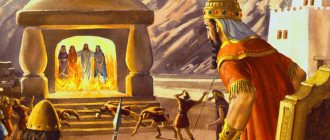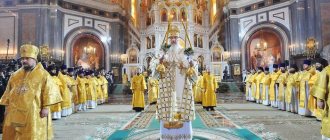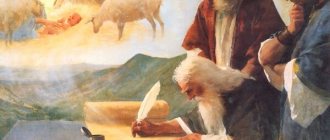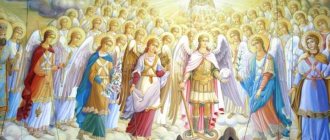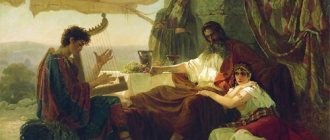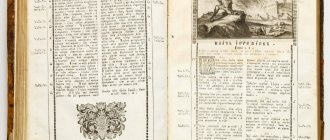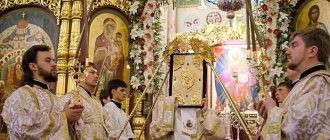Interpretation of the Book of the Prophet Ezekiel.
The book of the Prophet Ezekiel was written under King Nebuchadnezzar. Jewish exiles in Babylonian captivity tried to preserve their religion in a foreign land. Now they had a new understanding of the prophecies of Jeremiah, who had previously been persecuted. They needed a new prophet, which Ezekiel became.
Ezekiel lived in difficult times and found himself in a difficult situation. On the one hand, he prophesied in a foreign land and not just among pagans, but among pagans who had their own culture and quite strong state power at that time. The entire Old Testament Church had to withstand and preserve itself in these conditions. The prophet Ezekiel clearly understood the importance of his tasks:
- Save your own religion
- Oppose the religion of the pagans, which seemed attractive to many.
At the center of the work is the glorification of the glory of the Lord. The same thought is repeated more than 60 times: God says that all his actions are necessary for man to realize the power and glory of the Lord.
And the slain will fall among you, and you will know that I am the Lord.
...and they will know that I am the Lord; It was not in vain that I said that I would bring such disaster upon them.
And you will know that I am the Lord when the slain lie among their idols around their altars...
Ezekiel is often called the divinely inspired interpreter of the Babylonian captivity. An interesting fact is that according to many researchers, Ezekiel rarely prophesied among the people; he wrote down the prophecies and they were read.
Ezekiel was “the priest, the son of Buzi,” prophesied in Babylon (1:3). His name meant “God will strengthen.” Apart from Jeremiah and Zechariah, only Ezekiel was both priest and prophet; all three prophesied during and after the Babylonian captivity. He was taken from Judah to Babylon with the first group of immigrants, along with King Jehoiachin. He prophesied approx. 22 years, approximately from 593 to 571 BC, that's how long the Levites served (Numbers 4:3) from 30 to 50 years.Ezekiel foretold the fall of some of Judah's pagan neighbors who mocked God's people, as well as the restoration of the temple in Jerusalem and the return of Jehovah's favor to Israel. Many of his prophecies also describe the thousand-year reign of Christ.
Ezekiel 1:1-28 Seeing the likeness of Jehovah's glory
Ezekiel's early calling was to turn the hearts of God's exiled people to Jehovah. To strengthen him for the difficult task, God sent him a vision of His glory.
1:1And it came to pass in the thirtieth year, in the fourth month, on the fifth day of the month,
Some theologians agree that the "thirtieth year" perhaps indicates the age of the prophet Ezekiel at the time of his calling. As Scripture shows, the age of the priests called to serve in the temple was thirty years, and Christ was also called to a special ministry at the age of 30. Then it becomes clear why Ezekiel was called by God at his thirtieth birthday for a special ministry (Numbers 4:3)
While I was among the exiles by the river Chebar,
the heavens were opened, and I saw visions of God. Chebar River
- Babylonian Canal. “The heavens were opened,” the expression suggests that Ezekiel was given a vision in a form in which he could “digest” and perceive it. Interestingly, centuries later, the heavens open to Stephen, who is stoned for standing up for God's interests on earth. Few prophets were honored by God to see the “open heaven,” but they have one thing in common - they were all messengers of Jehovah. This suggests that Jehovah reveals his intentions to those who are close to him in spirit, and not to everyone, his chosen slaves. (Amos 3:7)
1: 2 On the fifth day of the month (it was the fifth year from the captivity of King Joachim)
“King Joachim”
inaccuracy syn.trans.
,
should be understood as Jehoiachin. Since Joachim was buried in Jerusalem. (2 Kings 24:6) And Jeconiah was carried away into captivity.
1:3The word of the Lord came to Ezekiel the son of Buzzi, a priest in the land of the Chaldeans, by the river Chebar; and the hand of the Lord was there upon him.
God chooses Ezekiel for a special ministry.
«priest"
indicates that he was chosen from the womb (priestly functions were transmitted through the line of Aaron) and sanctified by Jehovah, just like Jeremiah and John the Baptist. The priest was to be Jehovah's messenger, speaking to the people on God's behalf, which Ezekiel subsequently did (Malachi 2:7). Ezekiel describes the vision:
1:4
And I saw, and behold, a stormy wind came from the north, a great cloud and swirling fire, and a brightness around it.
The wind and the cloud and the fire that appeared before the eyes of Ezekiel were not the usual phenomena of nature: arising from the descent of God into the near-earth spheres, they were signs of theophany;
by the nature of fire, as one of these signs of God, they call it “a consuming fire” (Exodus 24:14, Heb 12:29) Another “sign” was the already well-known “great cloud” (Exodus 19:16, Exodus 40:38): “descending” into the material world, God hid Himself from those to whom He appeared. And the “stormy wind” (the third “sign”) was not just stormy - it is no coincidence, apparently, that in the Septuagint Heb. ruach
was translated not as “wind”, but as “spirit”. There is another passage of Scripture in which “the spirit (wind) rushed over the deep” - Genesis 1:2.
«stormy wind
"showed the greatness and power of God (Job 38:1, Isaiah 29:6) In general, these three phenomena characterized the presence of God. The fact that the storm comes from the north indicates the spiritual mountain of Jehovah, where Jehovah and his assistants hold conferences. (Job 26:7; Isaiah 14:13,14) The light around the fire symbolized that Jehovah is the source of spiritual and literal light for all his subjects. There is no life without him.
1:5and from the midst of it is like the light of a flame from the midst of fire; and from the middle of it the likeness of four animals was visible - such was their appearance, like that of a man;
Flaming eyes from the middle of the fire indicate the ability to pierce with a glance - the pure eyes of Jehovah's servants, who have the same view of things as Jehovah.
«Looks like a human
“says that they are also created in the same image and likeness of God. Not externally, but internally: having a reflective mind and experiencing feelings. A further description of their faces and limbs will only confirm the idea that the animals reflected the glory of God and had the same qualities as those inherent in Jehovah.
1: 6-10 And each of them had four faces, and each of them had four wings;
7 And their legs were straight legs, and the soles of their feet were like the sole of a calf, and they shone like bright brass. 8 And the hands of men were under their wings, on their four sides; 9 And they had faces and wings, all four of them;
their wings touched one another; During their procession they did not turn around, but walked each in the direction of their faces. Four faces were each turned in its own direction, which means that the direction of activity of the cherubim (for the name of the animals, see Chapter 10 of Ezekiel) is to all directions of the world. 4 faces and 4 wings, according to the number of cardinal directions, they move straight, they do not need to turn.
Legs flaming with shiny copper mean the purity of the ways of the cherubim, their righteous and holy paths. Straight legs are a symbol of the straight path, the correct path, the direction of which is in accordance with the will of the Creator, Jehovah. The feet symbolize endurance, the ability to overcome long distances to do the will of Jehovah. Human hands under the wings symbolize reasonable actions - actions dictated by love for Jehovah and neighbors. The fact that the animals do not turn around means that they do not retreat, fulfilling the will of Jehovah.
1: 10-12
The likeness of their faces is the face of a man and the face of a lion on the right side of all four of them; and on the left side the face of a calf in all four and the face of an eagle in all four. 11 And their faces and their wings were divided above, but each had two wings touching one another, and two covered their bodies. 12 And they walked, each one in the direction that was before him;
Where the spirit wanted to go, that’s where they went; They did not turn around during their procession. See also Ezekiel 10:15 on the difference in the faces of the cherubim. The faces of spirit animals reflect the attributes of Jehovah. Leo - courage, strength, power, the royal majesty of Jehovah. Man - the ability to think logically and reflect, to feel love Taurus - endurance and hard work, perseverance and perseverance, long-suffering Eagle - wisdom, farsightedness, the high position of Jehovah, the spiritual ability to foresee the consequences of one’s decisions. Animals go where the spirit tells them - all decisions are made the same as Jehovah would make (in accordance with His will). They didn’t turn around are associated with the fact that animals make decisions without looking at their own interests, they care about God’s.
1: 13,14 And the appearance of these living creatures was as the appearance of burning coals, as the appearance of lamps;
[fire] walked among the animals, and a radiance came from the fire and lightning came from the fire. 14 And the animals moved quickly to and fro, like lightning flashing.
As we see, animals, like all of Jehovah’s creatures in the sky, reflect the light of Jehovah, reflecting the qualities of Jehovah, his essence. Just as Jesus, while on earth, reflected the essence of the Father. The speed of movement of animals shows not only the lightning speed of movements, but also decisions.
1: 15-21
And I looked at the living creatures, and behold, on the ground beside these living creatures, there was one wheel in front of their four faces. 16 The appearance of the wheels and their structure is like the appearance of topaz, and the likeness of all four is the same; and from their appearance and their structure it seemed as if there was a wheel within a wheel. 17 When they went, they went to their four directions; They didn’t turn around during the procession. 18 And their rims were high and terrible; All four of their rims around were full of eyes. 19 And as the living creatures walked, the wheels also walked beside [them]; and when the animals rose from the ground, then the wheels also rose. 20 Wherever the spirit wanted to go, there they went; Wherever the spirit went, the wheels rose along with them, for the spirit of the animals [was] in the wheels. 21 When they went, they also went;
and when they stood, they stood; and when they rose from the ground, then the wheels also rose along with them, for the spirit of the animals [was] in the wheels. A figurative arrangement of animals whose spirit is in their wheels, which indicates the function of animals to observe what is happening in the universe from the point of view of Jehovah (Proverbs 15:3), and report to Him about what is happening. The fact that animals go in four directions shows their ability to be in different places at the same time.
1: 22-24
Above the heads of the animals there was the likeness of a vault, like the appearance of an amazing crystal, stretched from above their heads. 23 And under the arch their wings stretched out straight one to the other, and each one had two wings that covered them, each one had two wings that covered their bodies. 24 And as they walked, I heard the noise of their wings, like the noise of many waters, like the voice of the Almighty, a great noise, like the noise of an army;
[and] when they stopped, they lowered their wings. There was a vault above the animals, then we will see Him sitting on the Throne, which suggests that the animals obey the voice of Jehovah, being subordinate to Him. The wings covering the bodies of animals are figurative clothing with which they are covered as a sign of their obedience to Jehovah. Let's remember Adam and Eve. They were clothed before God in a spiritual sense. But having eaten the fruit from the forbidden tree, they stood naked and naked in shame before Jehovah. Since nakedness often denotes unrighteous deeds in Scripture (Rev 3:17), animals covered with wings indicate that they fully listen to Jehovah, and are clothed before him - without spot or blemish. “The Sound of Many Waters” shows both a loud noise and a soft one at the same time. The sound of the wings is reminiscent of the sound of a waterfall, mesmerizing with its pleasant and soothing noise.
1: 25-28
And a voice came from the vault that was over their heads; when they stopped, then they lowered their wings. 26 And above the vault, which was over their heads, [was] the likeness of a throne, in appearance as if made of sapphire stone; and above the likeness of the throne was the likeness of a man above it. 27 And I saw as it were metal burning, as it were the appearance of fire within it all around; from the sight of his loins and above, and from the sight of his loins and below, I saw, as it were, a kind of fire, and a radiance [was] around him. 28 In what form does a rainbow appear on the clouds during rain, this is the appearance of this radiance all around.
Here, as far as possible, Ezekiel is shown the majesty and power of Jehovah seated on the cherubim. Ezekiel is shown the splendor of Jehovah's throne in the form of a sapphire, a precious stone. Although we understand here: no stone can ever reflect the brilliance of the sky where Jehovah sits. And Jehovah himself is shown as a blazing fire - a magnificent God who is unchanging in his holiness, just as flaming metal is constantly pure from impurities. So Jehovah is constant and unchanging.
A radiance like a rainbow, as much as a rainbow can reflect the splendor of Jehovah's colors, His brilliance, radiance and majesty. Thus, Ezekiel's vision of the glory of the Lord was to strengthen Ezekiel for the further task that Jehovah would entrust to Him. The vision showed that God, with the help of his animals, oversees everything that happens in heaven and on earth. He possesses all the qualities that are depicted through animals: the strength and courage, and the royal majesty of a lion, because Jehovah is the King over all creation, the ability to love and be true to himself and others, to think and reason logically. Jehovah also has long-suffering, the ability to endure as long as necessary to achieve His purposes and fulfill His purpose. Jehovah also has unlimited wisdom, surpassing any human wisdom.
Literary features of the book of the prophet Ezekiel.
The peculiarity of the presentation style is that the prophet Ezekiel lived in a special world - on the edge of the unknown sacred world. His poetic language influenced apocalyptic writers, especially the work of the Apostle John.
The Book of Visions of Ezekiel has the clearest chronology of any prophetic book.
In book 2, the central themes are the judgment of the Jews (chapters 1 - 24) and the future restoration (chapters 33 - 48). Between these themes there is a third – balancing one. This is the theme of God's Judgment of other nations. Ezekiel predicts death for those responsible for the destruction of Jerusalem.
The book of Ezekiel is replete with proverbs and sayings. Many passages are in the nature of parables, visions, and allegories. The high drama of the visions did not leave the prophet’s contemporaries indifferent.
Due to the fact that the prophecies of Ezekiel were originally conceived as a literary work, and not as a speech to be pronounced, they are distinguished by their integrity and unity of form and content, as well as the consistency of their presentation.
The following style features should also be noted:
- the mystery of visions,
- priestly coloring,
- living imagery.
